This will be the space I will be writing for Eternal Titans, something that is both exciting and daunting. It does seem very hard to produce relevant articles on a consistent basis, so let’s see how far I can get. Just to get some things out of the way, I am an engineer and English isn't my first language, so my writing won't be super smooth. I also don't have any credentials, I'm no pro/semi-pro/wannabe pro of any card game, just someone who enjoys strategy and is trying to get better. Don't expect hard truths and teachings from a superior, enlightened and all-knowing mind. I will be sharing my thoughts, which are more often than not wrong, treat them just like another point of view and make up your mind however you want. I would love to hear your opinions too. Eternal has too many variables for anyone to know things for sure.
Now, to actual business; I really like to show and discuss interesting game situations. However, it is pretty hard to capture them with screenshots while trying to win games. So I will be showing these scenarios with homemade images and a couple of things will have different representations of what you see in Eternal:
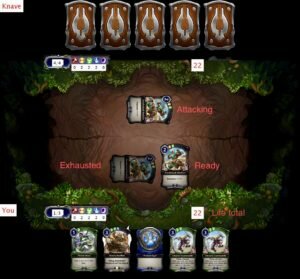
For my first article, I wanted to share 3 articles I have written for other platforms. Eternal has grown a lot since they were first published, so not everyone might have read them. Also, I'm quite proud of them.
It's So Quiet
The first one is about exploring the system of pauses of Eternal: https://rngeternal.com/2017/03/07/guest-article-leveling-up-with-pauses/.
Since then the card pool in Eternal has increased greatly, although some of the cards used in the examples were nerfed, the principles remained the same. Learning how to read pauses is one of the most important level-up moments in Eternal and a skill that anyone trying to play at a high level should have. Any of the better players in Eternal will be listing the fast spells and ambush units that their opponents may or may not have in their hand as they play the game and try to use this information to their advantage.
The main point of contention was on hiding pauses. In general, to hide pauses you have to eliminate the option of casting spells for a certain window of time, which can be disastrous if you then end up wanting to use that card. Moreover, you frequently end up giving away other types of information about your hand to hide fast spells (such as casting your creatures before combat).
Back then, I missed a technique to hide pauses so I wanted to show it here. Take a look at this example:
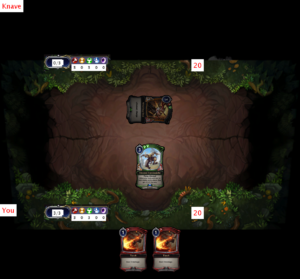
Here your turn will consist of Torching your opponent’s unit and attacking with Unseen Commando, but the order matters. If you Torch before attacking, during your attack step there will be a pause indicating that you have another fast spell. Conversely, if you attack first, you will show this same pause. However, after combat, you will use your first Torch and consequently your opponent will have no knowledge of your second one.
In most cases, however, there is a very hard to asses trade-off to spell hiding and in my original article, I restricted the examples to very simple cases where there was no downside to this practice. So I thought I could discuss some more realistic and trickier cases. The point here is not really to give a definitive answer about when you should do it or not, while writing these examples I changed my mind many times, but to show what are the types of pros and cons related to the situations that usually appear so you can make well-informed decisions on your games.
Let's look at the following 2 cases, should you play the Assembly Line before combat to hide your spells or not?
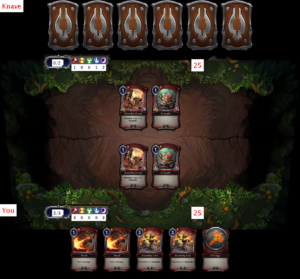

In these examples the boards are almost analogous and clearly I want to make a point here that not only does the board matter but so do the decks you are facing. In the first image, Fire, Primal and Shadow influence + Grenadin Drone give away that this is some sort of Haunting Scream deck. The second case can easily be identified as Praxis tokens. I was also ambiguous about which deck you are playing, so you could either be on a Sacrifice deck or an aggressive Bandit Queen deck, and that is also relevant, so let's analyse all possibilities.
Con: In all cases, the negative side of hiding your spell is that your opponent will know that you have Assembly Line as a follow-up play to your attack. Before showing the Line, your opponent may not be interested in blocking, both decks have cards that benefit from having random units on board (Devour, Xenan Obelisk, Bandit Queen, Rally) and they may feel their life is still manageable. It may not seem like a big deal since they will be able to block next turn. However, this leads you to deal two extra damage. Also, if you draw Bandit Queen next turn, you would be very happy to have two more units on the board.
Pro: For both cases, the advantage means hiding you have a Torch (for simplicity I will ignore other fast spells), but the effect of this card is completely different in each of these matchups.
Haunting Scream relies upon having big turns with Gorgon Fanatic and Vicious Highway Man, which can put them way ahead, so making them invest the resources to swing the game and countering it with a removal spell goes a long way towards winning this matchup. Moreover, it can not only play around it by casting other units first, but they can also set up Devour to 2-for-1 you.
Praxis Tokens doesn’t have any key units that can be caught by Torch. Not that the information has no value, your opponent will take into account your Torch when trying to go for lethal with Rally or refrain from playing Arcanum Monitor with only 2 other units in play, but nothing here is as critical to their game plan as Scream’s targets.
Clearly, I’m pointing out that you should probably hide against Scream and show against Tokens. But there is still one variable to be looked at: your deck. Sacrifice decks don’t really win by damage that often, especially against Praxis tokens, your path to victory is usually to go off with Stonescar Scrapper or Gearcruncher, so both hiding Torch and dealing two damage have little value and both lines are pretty equivalent.
This is a super lengthy discussion for a not very relevant play. Clearly, you shouldn’t think of all this for every decision you make during the game and you should follow your instincts. For each matchup you should develop a natural understanding of what matters and what doesn’t and shortcut these decisions. For example, when playing a Stand Together deck against control, I will value hiding my spells a lot, as countering Harsh Rule with it is a game-winning play. On the other hand, as a control deck, there are very few spells and situations for which I consider hiding my spell relevant, no one cares if you have a Wisdom of the Elders and, in most cases, your opponent can’t do that much to play around Deathstrike anyway.
Let’s look at another example:
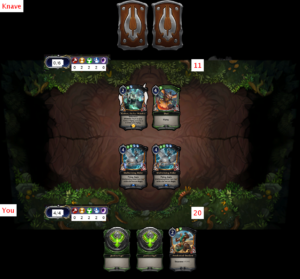
This is a TJP midrange mirror and you don’t really have any fast spells, but that doesn’t really matter as hiding something you don’t have is as valuable as something you do have. You are definitely attacking everyone here, but there are a few options on how you do it, you can:
- Just attack without hiding anything.
- Play Awakened Student, attack and then play a power. This way your opponent won’t know whether you have a Stand Together or not.
- Play Awakened Student, play your power and then attack.
At a first glance, there doesn’t seem to be any cost in “hiding” Stand Together and going for the second play: your opponent is forced to block one of your Sheltering Riders anyway. However, this sequence lets your opponent know that he doesn’t have to play around Stand Together during this block and can safely trade with your larger flier. If you play your unit first and go up to three open power, you are not only leaving Stand Together up but also signalling to your opponent that you have it, thus incentivising them to block the smaller bird.
No Android
The whole reading/hiding pauses are sweet tools in Eternal gameplay, but everything here is pretty marginal. If you really want to win more you need to work on your strategy and one of the most important steps towards that is learning to not only play games through your side of the board but also your opponent’s. It is very easy to forget that you are playing against another human being who is also plotting their own strategy and trying to foil yours during games. This was the topic of the second article I wanted to share here: https://www.reddit.com/r/EternalCardGame/comments/6f6xo8/understanding_your_opponents_plays/
Some of the examples there were a bit too complicated for what I was trying to convey, but the core ideas are super important, so maybe someday I can revisit the subject with clearer ideas.
Recently I had a game situation which exemplifies how it is easy to underestimate your opponent’s strategy and fall into simple traps: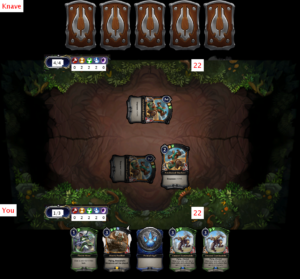
This is a TJP midrange mirror, you attacked on your turn and now your opponent is attacking back into your second Awakened Student. Now you can block your opponent’s dude and kill it with Finest Hour, which is a good way to eliminate a unit that may get out of hand quickly. The problem is that Finest Hour is a face-up card, meaning that you showed it to your opponent during your attack step on your turn. Consequently, blocking here is pretty poor and your opponent will only make this attack if he has a counter trick (their own Finest Hour or Equivocate) and getting a 2-for-1 is an easy way to lose your early advantage. This may seem pretty niche, but in its current incarnation the TJP mirror is almost entirely about these edges, where you can one-up your enemy in decisive combat steps involving combat tricks.
Everything Is Chance
This article is the one that I am the proudest of writing, even though it ended up leading to way more losses than victories: https://eternaltheory.wordpress.com/2017/04/08/trying-to-break-the-new-redraw-rule/.
One thing that I really missed from 50 power decks was Whispering Wind, which can really help increase your consistency and mitigate mana flood. I think these strategies are a bit overlooked, Crown of Possibilities and Stonescar Excavator can fit this shell quite well and always seem close to a competitive power level. Also, starting the game with three Infernus should be on everyone's Eternal bucket list.
Crazy strategies and fun factor aside, it is always good to be mindful of the implications of this redraw rule, more power cards translate into to greater non-power card consistency and vice-versa. A deck with 25 power is more likely to get an untapped Seat on turn 1 than one with 26, for example, so there are many nuances to deck building that may be explored.
That was all I had written about it, but now the new merchant cards bring new perspectives to these strategies. Between merchants and exploiting the redraw rule you can get your key card close to 100% of the time. In addition to that, they also help you mitigate power flood. On the other hand, merchants allow for some of this extra consistency without all the hassle of playing 50 power. All things considered, I believe that Crown of Possibilities and Stonescar Excavator end up being more harmed than benefited from the addition of markets to the game, you can't sculpt your game plan around single relics winning you the game when your opponent can just barter for a Bore.
I Must Be Wearing My Welcome...
Well, this was way longer than I expected and I didn't even bother to read the old articles again. Anyway, it is good to know what people reading are thinking. What did I get wrong? What are you guys interested to read about in the future? I have a couple of strategy and draft articles lined up, but wouldn't mind some ideas.
